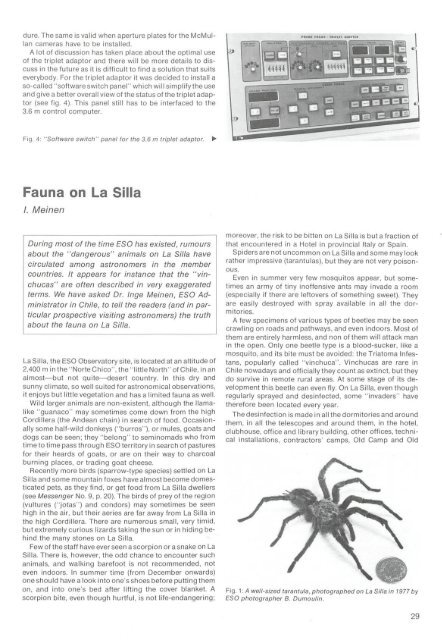The Triplet Adaptor Soon Ready for 3.6 m Prime Focus ... - ESO
The Triplet Adaptor Soon Ready for 3.6 m Prime Focus ... - ESO
The Triplet Adaptor Soon Ready for 3.6 m Prime Focus ... - ESO
You also want an ePaper? Increase the reach of your titles
YUMPU automatically turns print PDFs into web optimized ePapers that Google loves.
dure. <strong>The</strong> same is valid when aperture plates <strong>for</strong> the McMullan<br />
cameras have to be installed.<br />
A lot of discussion has taken place about the optimal use<br />
of the triplet adaptor and there will be more details to discuss<br />
in the future as it is difficult to find a solution that suits<br />
everybody. For the triplet adaptor it was decided to install a<br />
so-called "softwareswitch panel" which will simplifythe use<br />
and give a better overall view of the status of the triplet adaptor<br />
(see fig. 4). This panel still has to be interfaced to the<br />
<strong>3.6</strong> m control computer.<br />
....'MI .ocus<br />
"""Ln AOIII"U<br />
Fig. 4: "Software switch" panel <strong>for</strong> the <strong>3.6</strong> m triplet adaptor. ~<br />
Fauna on La Silla<br />
I. Meinen<br />
Ouring most of the time <strong>ESO</strong> has existed, rumours<br />
about the "dangerous" animals on La Silla have<br />
eireulated among astronomers in the member<br />
eountries. It appears <strong>for</strong> instanee that the "vinehueas"<br />
are often deseribed in very exaggerated<br />
terms. We have asked Or. Inge Meinen, <strong>ESO</strong> Administrator<br />
in Chile, to tell the readers (and in partieular<br />
prospeetive visiting astronomers) the truth<br />
about the fauna on La Silla.<br />
La Silla, the <strong>ESO</strong> Observatory site, is located at an altitude of<br />
2,400 m in the "Norte Chico", the "Iittle North" ofChile, in an<br />
almost-but not quite-desert country. In this dry and<br />
sunny climate, so weil suited <strong>for</strong> astronomical observations,<br />
it enjoys but little vegetation and has a limited fauna as weil.<br />
Wild larger animals are non-existent, although the Ilamalike<br />
"guanaco" may sometimes come down from the high<br />
Cordillera (the Andean chain) in search of food. Occasionally<br />
some half-wild donkeys ("burros"), or mules, goats and<br />
dogs can be seen; they "belong" to seminomads who from<br />
time to time pass through <strong>ESO</strong> territory in search of pastures<br />
<strong>for</strong> their heards of goats, or are on their way to charcoal<br />
burning pi aces, or trading goat cheese.<br />
Recently more birds (sparrow-type species) settled on La<br />
Silla and some mountain foxes have almost become domesticated<br />
pets, as they find, or get food from La Silla dwellers<br />
(see Messenger No. 9, p. 20). <strong>The</strong> birds of prey of the region<br />
(vultures ("jotas") and condors) may sometimes be seen<br />
high in the air, but their aeries are far away from La Silla in<br />
the high Cordillera. <strong>The</strong>re are numerous smalI, very timid,<br />
but extremely curious lizards taking the sun or in hiding behind<br />
the many stones on La Silla.<br />
Few of the staff have ever seen a scorpion or a snake on La<br />
Silla. <strong>The</strong>re is, however, the odd chance to encounter such<br />
animals, and walking barefoot is not recommended, not<br />
even indoors. In summer time (from December onwards)<br />
one should have a look into one's shoes be<strong>for</strong>e putting them<br />
on, and into one's bed after lifting the cover blanket. A<br />
scorpion bite, even though hurtful, is not life-endangering;<br />
moreover, the risk to be bitten on La Silla is but a fraction of<br />
that encountered in a Hotel in provincial Italy or Spain.<br />
Spiders are not uncommon on La Silla and some may look<br />
rather impressive (tarantulas), but they are not very poisonous.<br />
Even in summer very few mosquitos appear, but sometimes<br />
an army of tiny inoffensive ants may invade a room<br />
(especially if there are leftovers of something sweet). <strong>The</strong>y<br />
are easily destroyed with spray available in all the dormitories.<br />
A few specimens of various types of beetles may be seen<br />
crawling on roads and pathways, and even indoors. Most of<br />
them are entirely harmless, and non of them will attack man<br />
in the open. Only one beetle type is a blood-sucker, like a<br />
mosquito, and its bite must be avoided: the Triatoma Infestans,<br />
popularly called "vinchuca". Vinchucas are rare in<br />
Chile nowadays and officially they count as extinct, but they<br />
do survive in remote rural areas. At some stage of its development<br />
this beetle can even fly. On La Silla, even though<br />
regularly sprayed and desinfected, some "invaders" have<br />
there<strong>for</strong>e been located every year.<br />
<strong>The</strong> desinfection is made in all the dormitories and around<br />
them, in all the telescopes and around them, in the hotel,<br />
clubhouse, office and Iibrary building, other offices, technical<br />
installations, contractors' camps, Old Camp and Old<br />
Fig. 1: A well-sized tarantula, photographed on La Silla in 1977 by<br />
<strong>ESO</strong> photographer B. Dumoulin.<br />
29
















